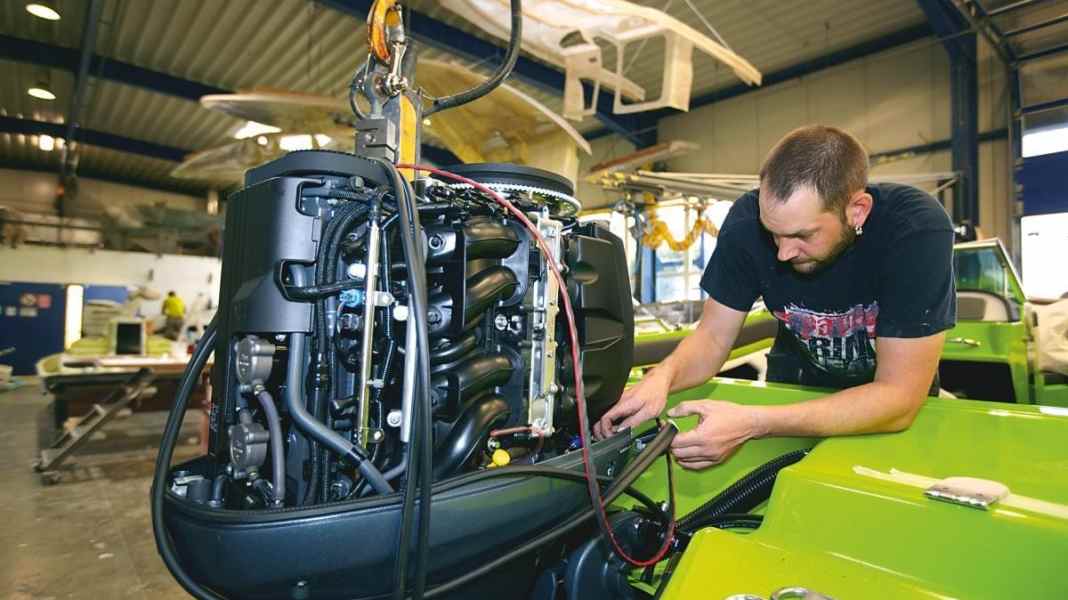
And it's true: to err is human. "The Americans are gradually saying goodbye to two-strokes", wrote the author in the last comparison test of the 150 hp class (BOOTE 8/02) and has to correct himself here and now. With Evinrude and Mercury's Optimax, this test pits the species that has been declared dead against the four-strokes in a double pack. With Mercury's F 150 and Verado, they come from the same country as the two-strokes and from the Far East. Namely from Suzuki and Yamaha. Honda, the "inventor" of the four-stroke outboard motor and winner of the 150cc test together with Suzuki at the last class reunion, turned down the BOOTE testers.
Nothing has changed in the fact that the 150 hp engines looking for a job prefer sport and cabin cruisers in the 6 to 7 metre class and inflatable boats with solid hulls. Then as now, their application documents emphasise modern technology, high performance and ease of operation.
Technological progress is responsible for the fact that the Evinrude E-Tec and Mercury Optimax fulfil all mandatory exhaust emission standards and thus survive in the realm of four-strokes to this day. Carburettors have not existed in this power class for what feels like ages. In addition, the two-strokes can do without valve control components. Despite the V-6 block, this makes Evinrude and Optimax leaner, or rather significantly lighter than the four-stroke competition.
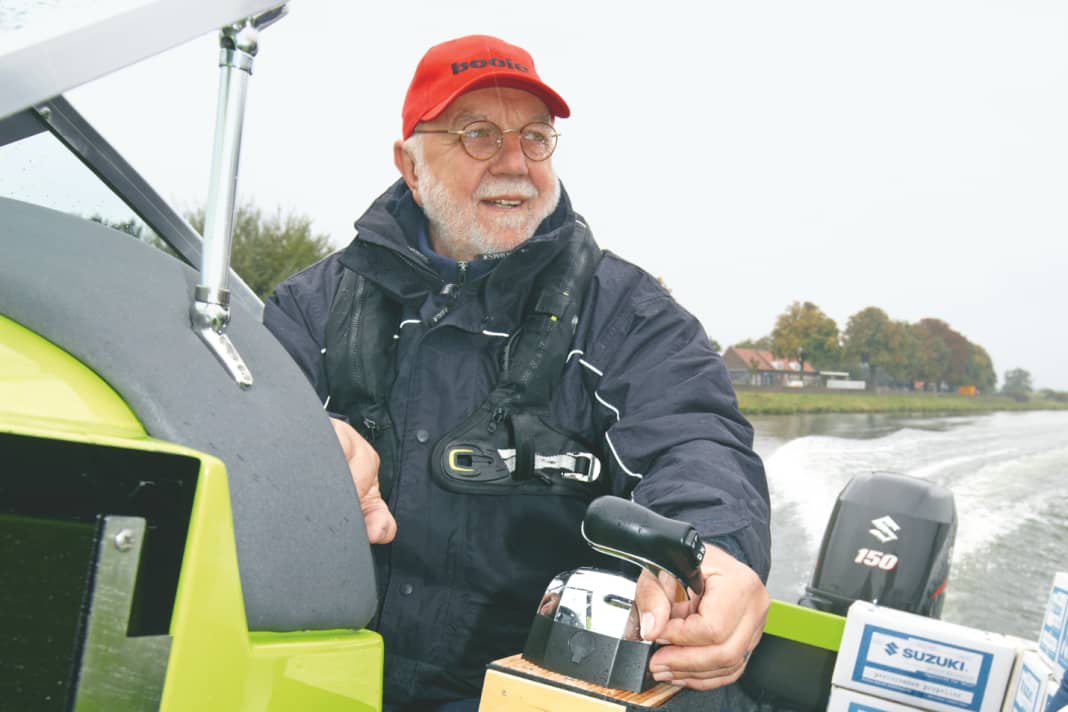





Neither Evinrude nor Mercury want to advertise the fact that the two two-stroke engines have a power stroke for every revolution of the crankshaft and are therefore "perceived twelve-cylinder engines". What they do want to advertise is electronically controlled sequential direct injection and ignition. Sequential means that the fuel is injected directly into the combustion chamber in several small, finely atomised "portions" without mixing oil. The control electronics determine when and how much petrol is injected and when the spark, which ignites at millisecond intervals, "jumps over".
The computer and its mechanical assistants also ensure that the oil required for lubrication is automatically and precisely metered directly to the lubrication points. A distinctive feature of the E-Tec engine is the high stability of the design, which allows maintenance intervals of 36 months. The automatic winterising function is unique.
Trademark of the Mercury Optimax: a compressor that makes it easier for the engine to "catch its breath". That makes it strong. The Verado's powerful "breathing apparatus" (compressor and intercooler) is electronically controlled. This means that it only starts up when it is really needed, preferably when accelerating. In this way, Mercury wants to make the second generation of Verados (from 2008), which have forged pistons, a completely newly developed engine management system and a modified underwater section, significantly more economical.
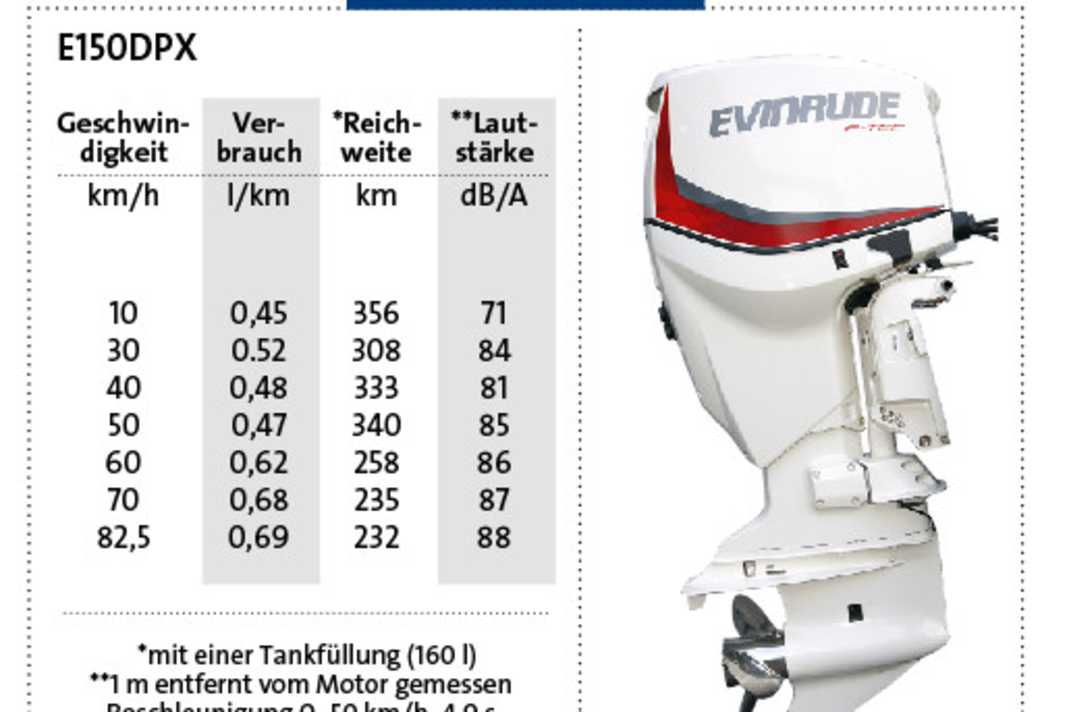





What remained were the four in-line cylinders, the smallest displacement (1732 cc) in the test, two overhead camshafts, four-valve technology and electronic petrol injection. All this and the comfortable electronic gearbox, which, unlike the electronically controlled steering, is standard equipment on the Verado, is as heavy today as it was then. In figures: 257 kg. This also makes the Verado the heavyweight in this test.
What also remains unchanged is that modern technology and comfort are one thing, price is another. Those responsible at Mercury wanted an inexpensive alternative, and Claus Brüstle, now Head of Technology at Neander-Motors AG in Kiel (the company that wants to bring the first turbodiesel outboard to series production), developed it.
The result is an in-line four-cylinder engine that stands out less for its modern technologies - an OHC engine with electronic fuel injection (EFI), two-valve technology and mechanical gearbox is "black bread" for engine manufacturers these days - than for its large displacement and ease of maintenance. In addition to the attractive price, the compact design and low weight are also impressive. In short, no four-stroke engine in this test is cheaper or lighter than Mercury's F 150 EFI.
Suzuki has gone the other way round and upgraded its technology and comfort. The downside of this policy can be seen on the scales and in the price list. Everything has its price, and that of the DF 150 TGX is significantly higher than that of its test competitors. In return, the Suzuki buyer receives an in-line four-cylinder engine with two overhead camshafts, sixteen valves and variable timing, which should ensure high torque and thus excellent acceleration values even at low and medium engine speeds.
Like their colleagues, the Suzuki engineers also want to save fuel and reduce pollutant emissions. And they do this with computer-controlled petrol injection and transistor ignition and a variable intake system. When everything is right, the precisely calculated quantities of fuel and air are optimally mixed in every situation and ignited at exactly the right time. At Suzuki, this is called "Lean Burn" and is a clean and efficient process.

The most striking advance of the DF 150 is the abbreviation TG, which stands for the term "drive-by-wire", i.e. an electronically shifted gearbox. The price also includes the double reduction (crank/driveshaft and gearbox). This brings the engine closer to the boat's transom, improves the balance and allows really large propellers to be fitted.
With Yamaha's F150, a veteran enters the ring. However, with the exception of the mechanical gearbox shifting, experienced means anything but old-fashioned. The engine management system, which controls the injection system and ignition electronically, DOHC (Double Overhead Camshaft), four-valve technology and the electronic immobiliser are state of the art and make the Yamaha more than just competitive in terms of fuel efficiency. Even when it comes to cubic capacity, weight and price, the in-line four-cylinder from the Far East leaves more than one "market competitor" behind.
Leaving aside the electronically switched gearboxes that characterise Evinrude, Suzuki and Mercury's Verado, the test engines are closely matched under the heading "Equipment". A po-wheel trim, with which the engine can be raised and lowered continuously while travelling and thus the boat can (almost) always be brought into the optimum floating position, is just as much a standard feature as an automatic cold start system, which starts the engine after just a few revolutions and allows it to run smoothly immediately. And all without smoke signals, of course. Another standard feature is the absence of a sensible fuel pre-filter (appropriate to the engine size) with water separator, which all manufacturers recommend and have in their (accessory) programme, but none of them supply as standard.
The warning systems deserve praise. Faults such as low oil and oil pressure, overheating and excessive speed are signalled visually and acoustically in unison and the speed is automatically limited.
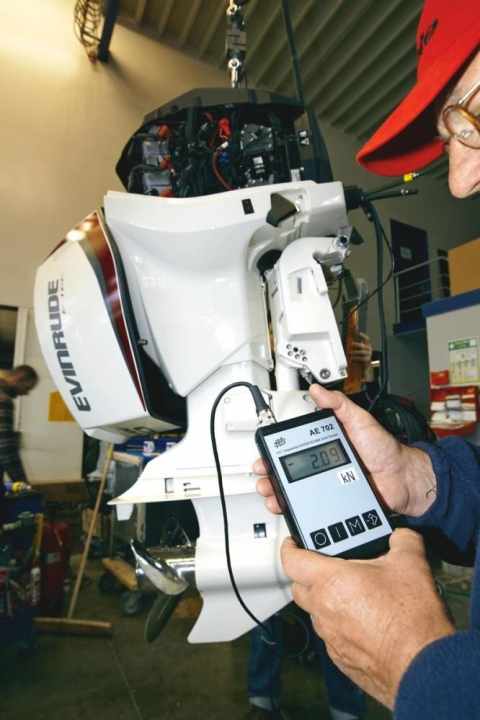
The fact that the electronics store these and other facts and make them visible on "request" is, in case of doubt, more pleasing to the service technician than the customer. In addition to the warning lights, the rev counter and trim indicator show how the engine is currently doing and where it is currently "at". Speed, fuel consumption, range, battery voltage, operating hours and tank capacity are also displayed.
If "King Customer" wants to carry out simple maintenance work himself, which he should not actually do, he will find a few useful tips in the clear and informative manuals, which mainly describe and explain the handling of the engine, and which are always sufficient for changing the filter, oil and propeller. By the way: the matching stainless steel propeller is available at no extra charge, with one exception - Yamaha only provides an aluminium propeller. The customer also has a free choice when it comes to the shaft length (508 or 635 mm) and the gearbox rotation direction (right or left), which is important for twin engines.

The test sextet's favourite "workplace" is a Hellwig Milos 630 Open (the boat test will appear in a future issue of BOOTE), a 6.30 m long and 750 kg (without engine) heavy German bowrider. At 640 mm, it has the right transom height and has impressed the BOOTE testers more than once as a "closed bow version" with its excellent handling characteristics. The measurement results and the testers' sensitive "popometer" show that it does not need the maximum permitted 225 hp to do this.
The engine manufacturer's technicians, who as always are responsible for engine installation and propeller tuning, choose the "third hole" as the mounting height. This means that the anti-cavitation plate is about 2 cm higher than the bottom of the boat. This allows all engines with the power trim to be raised to the highest position without ventilating. Provided you are travelling in a straight line. In tight bends, the stainless steel props from Evinrude and Suzuki draw air a little sooner than the test competition. The precision and smoothness of the Verado's electronic steering (Extra) is impressive in these situations. It is noticeable that maximum trim does not mean maximum speed. Less is more. And that applies to all test engines.
The fastest (83.7 km/h) is the Milos with the lightweight Optimax; Mercury's "piggy bank", the F 150, is only just behind. Third to fifth place went to Yamaha, Suzuki and Evinrude. The Verado is the only one in our test that cannot "crack" the 80 km/h mark and therefore lags behind its test competitors.
The fact that the 19" propeller, which "only" allows the Verado to turn 6000 rpm instead of the permitted 6400 rpm at full load, is perhaps a size too big is also evident when accelerating. Despite the supercharger, the Verado does not achieve more than two sixth places in this discipline either. Whether accelerating from 0 to 50 or 70 km/h, the sprinter king is the Mercury Optimax. Unsurprisingly, Evinrude is the other two-stroke engine in second place. The Suzuki is the fastest four-stroke. Yamaha, stronger on short distances, and Mercury's F 150 alternate in fourth and fifth place.
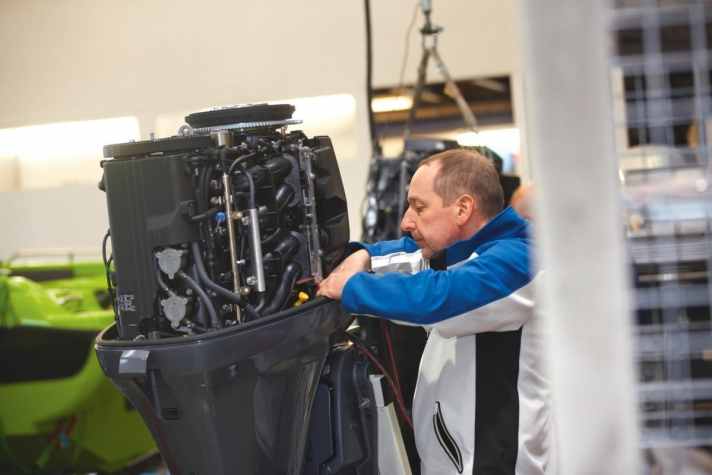
If you buy a four-stroke, you want an economical and quiet engine. And you get it! If you take the values measured at cruising speed (50-60 km/h) as a yardstick, the test winner is the Mercury F 150, which means that it is also possible without four-valve technology. The biggest surprise comes from the Optimax, which is more economical overall than the four-strokes from Suzuki, Verado and Yamaha. Evinrude's E-Tec does what BRP feared, it brings up the rear in terms of fuel consumption.
It should not go unmentioned that two-strokes run on a mixture of petrol and oil, and that outboard oil is not available for free. However, it is also clear that the annual oil and filter change for four-strokes costs money.
As we all know, the sound makes the music. And the Optimax is undoubtedly "heavy metal". Those who like it will perhaps not be put off by the 92 dB/A measured at 60 km/h, but everyone else will be annoyed. As expected, Evinrude's E-Tec is not much better. It is also loud. Yamaha and Mercury F 150, which, like the third-placed Verado, only becomes unpleasantly loud at full load, are really quiet. Suzuki is quieter at this point.
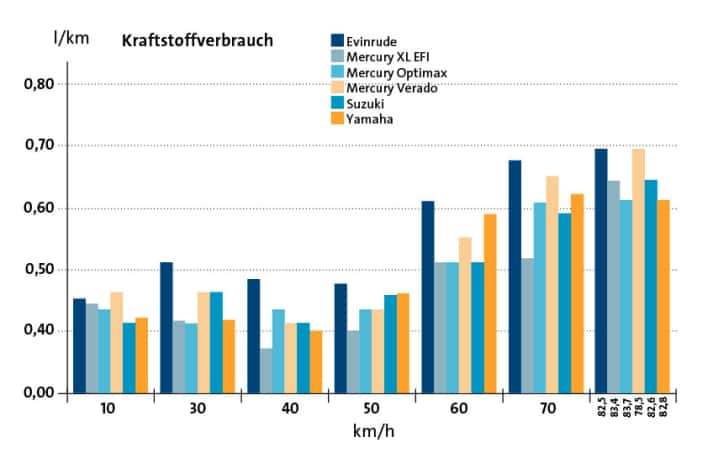


Conclusion: It is light, fast, economical, relatively inexpensive and - like all Mercury engines - comes with a 5-year warranty from the manufacturer. That should actually be enough for the Optimax to take top place in this comparison. But it is not. At least not according to the testers. They see the lack of smooth running, which is not only reflected in the noise level, and the inadequate ease of use of the mechanical gearstick as major negative points. Suzuki and Mercury's Verado are the best examples of how a modern outboard motor should be equipped in terms of technology, performance and ease of use.
It's a shame that the former is "expensive as hell" and the latter is driving with the handbrake on in this test. The engineers have taken away the Verado with the large propeller's thirst and volume, but also its temperament. Yamaha's F150 is, with the exception of the noise level, never at the top of the test results, but never at the bottom either and is therefore placed in the midfield together with the F 150 from Mercury, which impresses in terms of price and fuel consumption, due to its mechanical gearstick.
The Evinrude remains the cheapest engine in the test. Electronic gear shifting, sprinter qualities and low maintenance requirements speak in favour of the E-Tec engine. As with the Optimax, points of criticism are the thirst and the slightly better, but still anything but lush running culture in the internal two-stroke comparison. This means that only sporty, ambitious buyers are likely to opt for one of the two-strokes. The bottom line for the BOOTE testers is that the Suzuki is the first choice.

